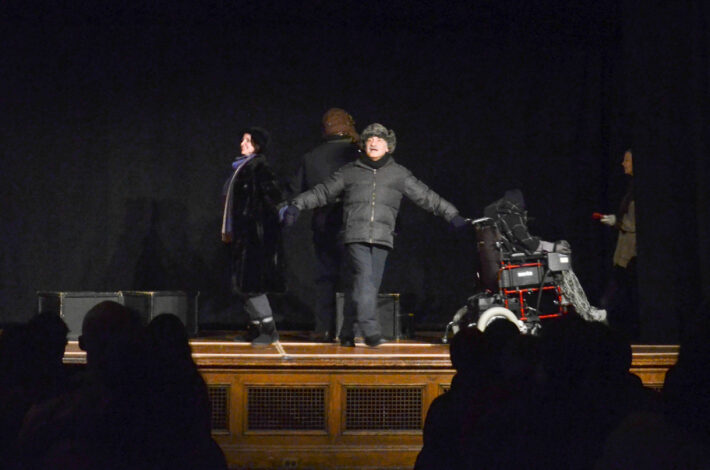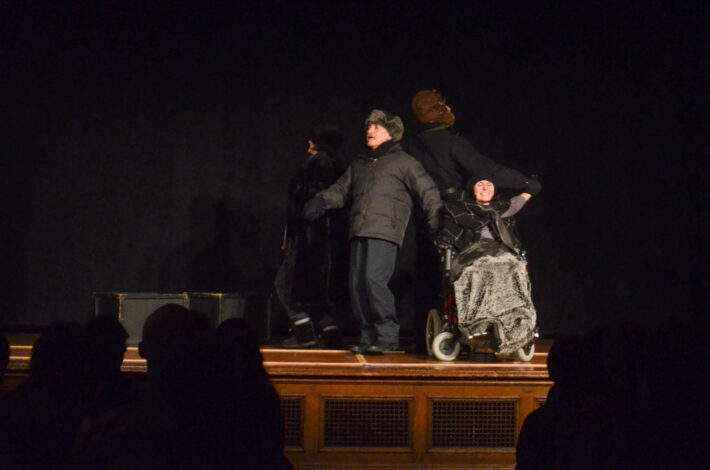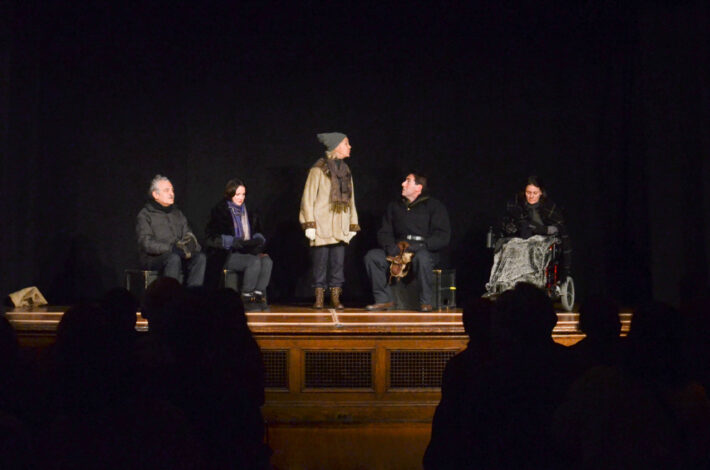
The play is about to begin. Folk music resounds in the hall. A few of the 40 audience members are visually impaired or use a wheelchair. In the third row, an old man with closed eyes and a folded cane pats his legs energetically to the music.
When the curtain opens, a woman in a wheelchair and two men enter the bare stage, all wearing black goggles. The scene is very physical: The two men dance around the stage with linked arms, and later, one of them, called Granduncle, stands between the two others, holding them back from a fight.
In the next act, Granduncle takes off his goggles, and it becomes clear that the actor is visually impaired: his eyes are closed most of the time.
“The Granduncle Quadrilogy,” whose cast of six includes three legally-blind people playing sighted characters and one actress with multiple sclerosis, is the latest production by Theater Breaking Through Barriers (TBTB), the only company in NYC that integrates artists and staff members with various kinds of disabilities. The 36-year-old professional group, which puts on one to two major productions a year, works to advance actors with disabilities in an industry with widespread prejudice against them.
“Our goal is to change people’s perception of performers with disabilities,” says Nicholas Viselli, the company’s artistic director, who is not disabled. “And what better way to do it than to beat other companies at their game with people they won’t hire?”
The New York Times reviews most of TBTB’s productions, which includes many Shakespeare plays and British and American comedies.
“The Granduncle Quadrilogy,” in which Brooklyn-based playwright Jeffrey Lewonczyk depicts an absurd, war-torn world, is a departure for TBTB in terms of genre and the amount of physicality, Viselli says. To help the three visually impaired actors navigate the stage, the crew taped a few ropes across it, dividing it into a grid similar to a coordinate plane. The long tapes run along the ropes and hide them from view, and during the show, the three performers often have one foot on a tape. They also rely on memory and sounds coming from other actors to position themselves.

Fred Backus, the play’s director, praises the dedication of George Ashiotis, 67, who is a founding member of TBTB and has come out of retirement to play the title role. “Granduncle gets beaten up a lot. George is completely blind, and he’s no spring chicken, but he went for it, he was completely fearless,” he says.
Yet Ashiotis does not want the audience to focus on his disability. “I feel sometimes I’m judged by how successful I am at playing sighted, as opposed to how well I interpret my role,” he says.
For cast member David Rosar Stearns, 35, who is partially sighted and plays an enemy soldier who becomes Granduncle’s friend, the best part of rehearsal comes after all the problems related to eyesight and the wheelchair’s routes are solved.
“And it just starts happening,” he says, snapping his fingers. “You feel you have a play there. That really makes you confident.”
The group rehearsed 60 hours for the two-hour show, but accidents and mistakes are a part of live theater. During one performance, Ann Marie Morelli, who uses a wheelchair and plays a girl in love with Granduncle, realized that her scarf was caught in a wheel. To fix the problem without being noticed, she yanked it out with small nervous movements typical of her character.
“Things like that is always fun,” she says with a smile. “There is always a way out.”
The tragi-comedy ends with an emotional, ambiguous sigh from Ashiotis as his character dies. Audience member Bob Laine, an actor at Inverse Theater, an off-Broadway group, says he loves the performance and only noticed one vision-impaired actor.
“The show holds up against any other off-Broadway production,” he says. “The visual impairment of Granduncle brings double meaning to the script, since many lines revolve around sight and visual cues.”
John Sanfilippo, a visually impaired audience member, says he could follow the plot by ear. A fan of TBTB, he has attended its performances since the 80s.
“Ike Schambelan (the company’s late artistic director) would get up at the end of a show and say: ‘Who do you think is blind?’ And nobody can tell,” he says.
“Every actor has some sort of disability, in the sense that some are bad at memorizing lines, and some are bad at remembering where to go,” says Backus of actors in general. “What disabled actors don’t do well is more front and prominent for everyone to see.”
But not all directors and producers agree.
Only two percent of TV characters show disabilities and only a fraction of them are allowed to speak, according to TBTB’s website. On Broadway, seven shows featured characters with disabilities last year, but none of the actors playing them actually have disabilities, says David Harrell, an actor at TBTB and the Programming Associate at Alliance for Inclusion in the Arts, which advocates for full diversity in casting.
“People don’t see disability as a life experience that can add to the performance,” says Pamela Sabaugh, a partially sighted cast-member who has a M.F.A. in acting from Rutgers University.
She perceives strong stereotyping in the roles available to artists like her. “Nobody ever said to me: ‘I won’t cast you because you are blind.’ But I almost experienced the reverse—I wasn’t blind enough for the character, and have to make my vision seem a lot less than it is,” she says.
Harrell, who is born without his right hand, is bothered that people constantly relate disability to loss or inspiration. “The fact that I can put cereal into a bowl, pour milk in, and eat it with one hand is not really inspirational,” he says.
Viselli, who is TBTB’s only full-time employee, says the company never has enough money, as disability “is a hard sell”. But thanks to a $15,000 travel grant from Theater Communications Group, a national organization supporting not-for-profit companies, TBTB could bring “The Granduncle Quadrilogy” to the International Blind in Theater Festival in Croatia (from Oct. 12th to 18th), which has the world’s oldest vision-impaired theater company. The festival organizers covered TBTB’s accommodations in Croatia, according to Backus.

Actors in “The Granduncle Quadrilogy” each earned $500, according to Ashiotis. They do various kinds of work outside TBTB to support themselves. Stearns, who has a M.F.A. in playwriting from Columbia University, sees TBTB, the first company to hire him, as his core group. He is auditioning constantly, and recently did a script reading at the Urban World Film Festival, memorizing his lines in advance. He also cares for people’s pets for extra income.
Morelli, who joined TBTB in 1997 and is married to Viselli, devotes most of her time to creative and administrative work at TBTB.
Sabaugh, who is married to Backus, has auditioned less since she became a mother a few years ago. This June, she did a staged reading at the Brooklyn Academy of Music.
Despite existing misconceptions, the performers interviewed all see positive change on the horizon.
Last month, Broadway saw Deaf West Theater’s production of “Spring Awakening,” which features deaf actors and actresses, sign language choreography, and the first Broadway singer in a wheelchair.
On September 21st, a dialogue between performers with disabilities and casting directors, co-hosted by Casting Society of America (CSA) and Alliance for Inclusion in the Arts, took place at New York Town Hall. The dialogue is aimed at helping casting directors understand the talents and needs of the performers and create more opportunities for them. During the meeting, Alliance for Inclusion introduced its database of 400 to 500 performers with disabilities from around the country.
Harrell, Sabaugh and Stearns participated in the event and feel this will help their careers.
Casting director Joy Dewing, who is on CSA’s Diversity Committee and attended the meeting, says she has only begun to understand the possibilities and complexities of casting theater performers with disabilities.
Rosalie Joseph, a casting director for TV, agrees. “I have never brought in a blind or deaf actor,” she says. “I don’t feel anyone in our community has done enough.”
“We can inspire new ideas in directors and producers,” says Dewing. “But we can’t make the final decision.”